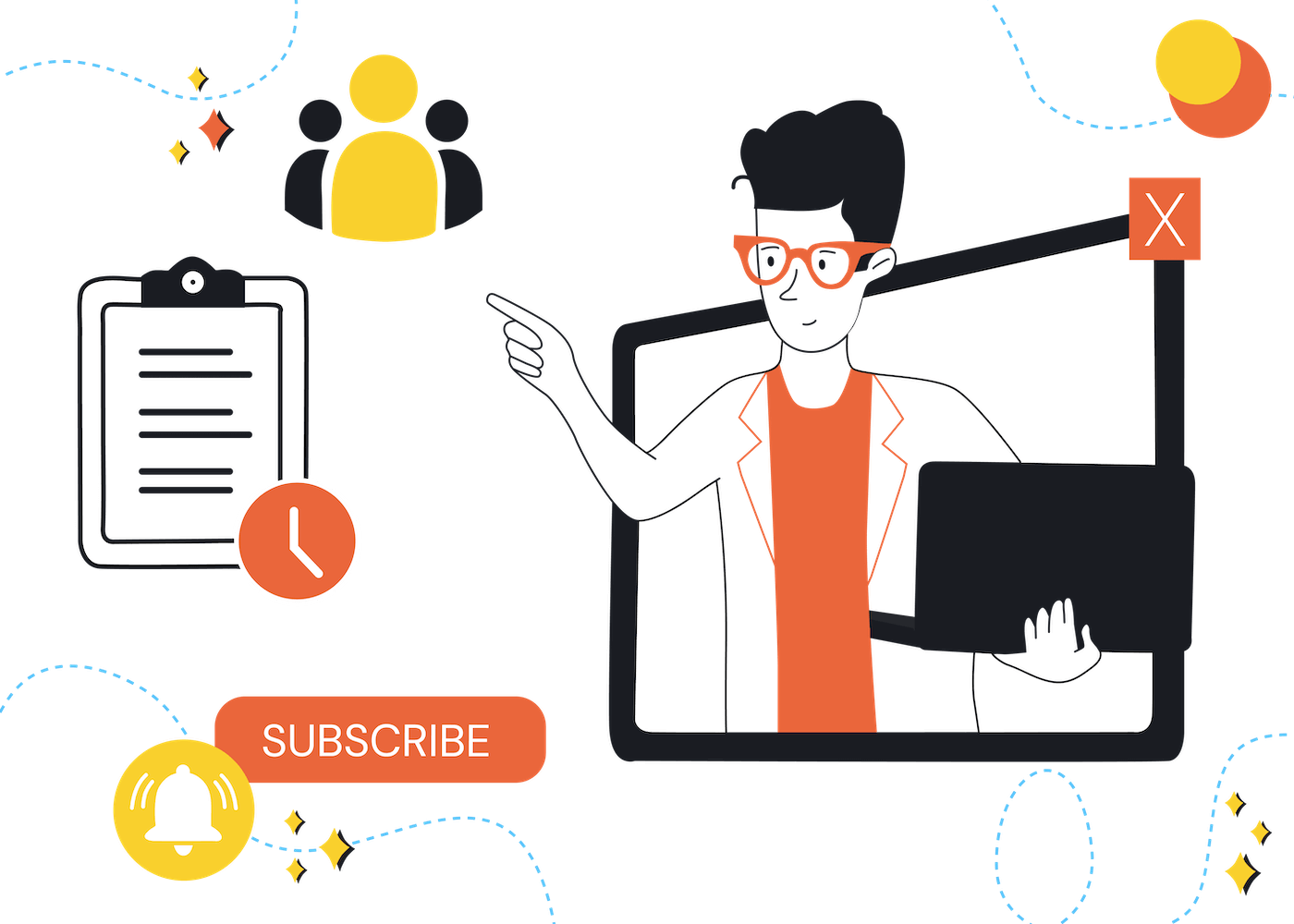If you wait until launch week to start emailing your list about your course (or product), you’re already behind.
Your subscribers need more than just information about your offer. They need anticipation, emotional buy-in, and a reason to care about what you’re selling before they buy.
That’s what we’re breaking down in this article — a simple 3-phase email marketing strategy that doesn’t just “announce” your paid course, but gets your audience excited to say “yes” to your offer.
Continue reading to learn how to build an online course launch strategy that:
- Gets subscribers raising their hands early with a waitlist
- Delivers a mini-course that builds trust and bridges into your offer
- Launches to subscribers who are already sold before they see the sales emails
Let’s dive in.
Phase 1: Use an Online Course Launch Strategy to Get People Interested
If you want subscribers to click “buy” when you launch your paid course (product), you can’t just drop it into their inbox out of nowhere. You must build hype before the pitch. And that starts with getting them curious and interested.
So, the goal of this phase is to build a waitlist of engaged and pre-qualified subscribers by:
- Talking about the problem they’re facing
- Sharing your idea for solving the problem
- Getting those interested to raise their hand
Here’s how to do it:
Talk about the problem
Before you sell the solution, remind your audience of the problem they’re dealing with. And don’t just name the problem.
Describe their fears, failures, and frustrations of living with it. Send emails about that thing they’re tired of Googling. That thing that keeps them up at 2 a.m. That thing they’ve tried to solve multiple times.
This level of specificity makes your subscribers feel seen and shows that you understand their problem.
Share your idea for solving the problem
While talking about the problem gets their attention, you also need to offer a possible solution.
Share your ideas and why you think it’d be the best solution for the problem, and make them curious about it. You may even talk about all the available solutions that they’ve tried and why they failed.
If you’re already sending regular emails, you don’t need a separate sequence for this. Just make your emails about this problem-solution, and casually invite them to join your waitlist.
Get interested subscribers on a waitlist
Not just a “drop your email for updates” kind of waitlist. Because you’re not just collecting names; you’re filtering for future buyers.
And the way to do that is by offering something that makes being on your waitlist feel like an opportunity, not a placeholder.
Sure, you can promise early access, a bonus offer, or a special discount. They’re great offers that would get some subscribers on the list. But most people would think, “Cool, but only useful if I actually decide to buy.”
So, level up your waitlist invite by promising something valuable they can get and use (whether they buy or not).
Something like a free email mini-course that helps your audience solve one key part of the bigger problem your product tackles.
This type of lead magnet doesn’t just grow your waitlist. It pre-sells your offer by giving them a taste of the kind of value you deliver and gets them a quick win that builds trust.
So, instead of “I’m launching a new course on the 11th, join the waitlist for updates and early access.”
Try something like: “I’m building something to help you fix [problem]. Join the waitlist and you’ll get a free 5-day mini-course to help you get started before the main product drops.”
Pro Tip: If you send newsletters, add a banner at the top to “promote” joining your waitlist. An example is Kieran Drew’s “Productize Your Knowledge” course launch. The course launched on July 4th, 2025. But he started promoting it in his newsletter as far back as May 10th.
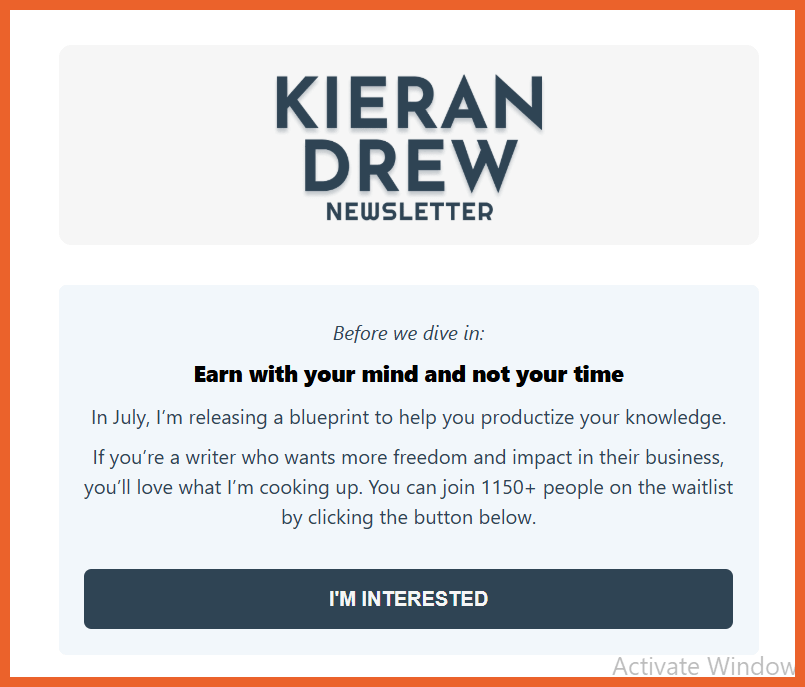
Source: Newsletter email from Kieran Drew
ESP Tip:
- Segment waitlist subscribers the moment they opt in, so you can send them targeted emails and deliver your mini-course promise
- Automate a confirmation + teaser email right after they join to set expectations, like the email below from Eman Ismail
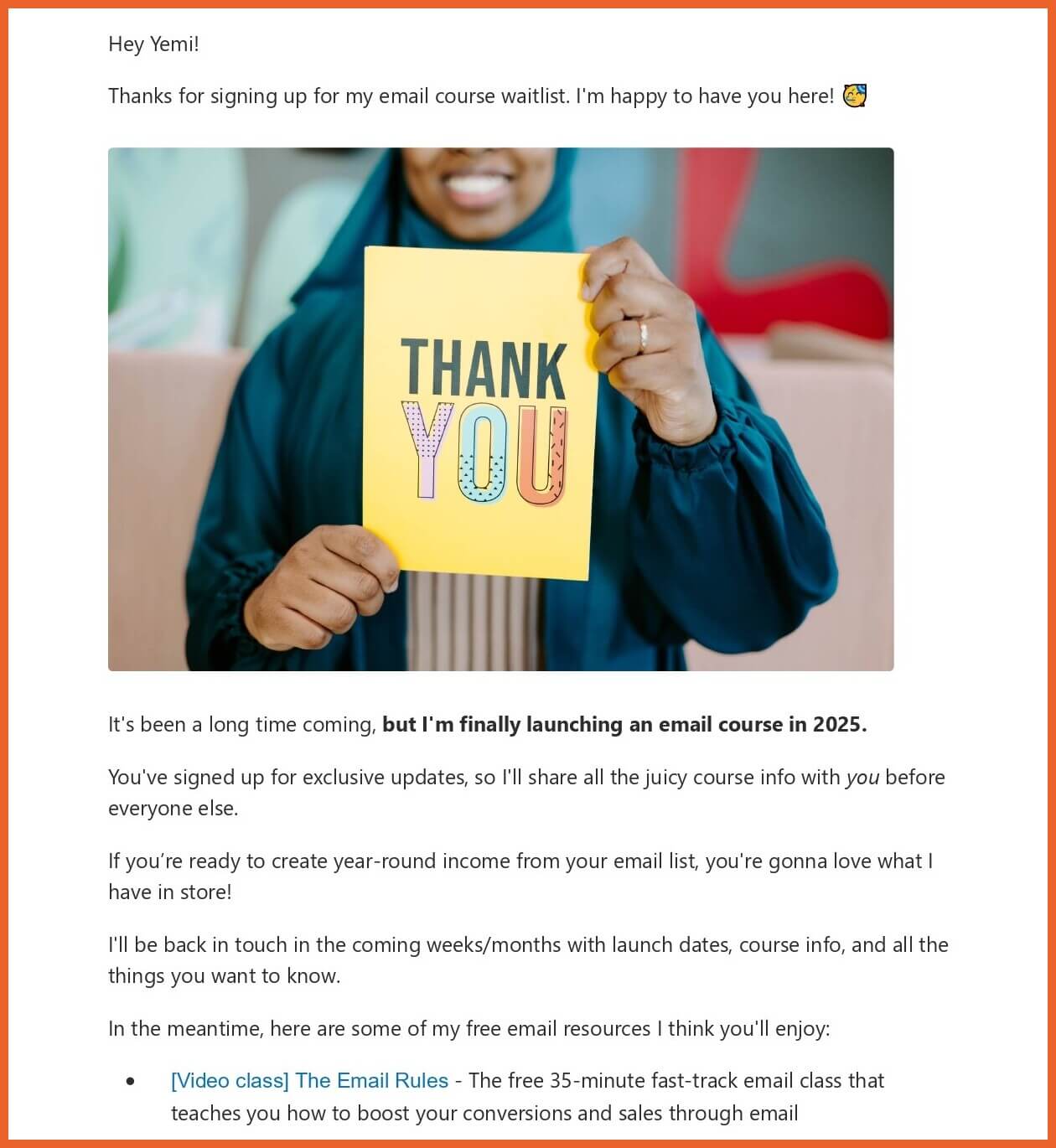
Source: Email from Eman Ismail
Phase 2: Warm Up Your Waitlist
Now that they’ve said “I’m in,” make them want what’s coming.
Getting interested subscribers to join your waitlist is only the beginning. The next most important step?
Making sure they’re still excited by launch day. Because if you disappear between “I’m interested” and “It’s live,” they’ll forget why they signed up in the first place.
So, this phase is where you stoke the fire and deepen the emotional connection by:
- Teasing the product details
- Involving subscribers in the process
- Building anticipation for the free mini-course
Here’s how to do it:
Tease the product details
You don’t need to spill the details of every feature, module, or bonus yet. But you do need to share enough details to keep the curiosity alive.
Even if you’re still mid-build, start dripping out sneak peeks and future-pacing the outcomes. Let them see the messy middle — progress screenshots, frameworks you’re sketching, or bonuses you’re considering adding.
Use phrases like, “I just finished recording a lesson on [topic]. This one’s going to change how you [result]…” “Since you’re on the waitlist…” or “Sharing this with you first…”
Sharing this behind-the-scenes process reinforces your waitlist’s insider status and makes them feel like they’re part of a private, early-access crew.
Involve them in the creation process
Don’t just share product updates with your waitlist. Start conversations and invite them to participate in building your course.
Ask for input on what they’d love to see inside. Let them vote on the product name (or bonus offers). Maybe even call for beta testers or reviewers.
Every click, reply, and vote deepens their emotional investment. And when launch day comes, they’re more inclined to say “yes.” Because you’re not just saying “buy this.” You’re saying, “You helped build this to fit your needs.”
An example is the email Amy Posner sent to her list requesting feedback for two memberships she was building.
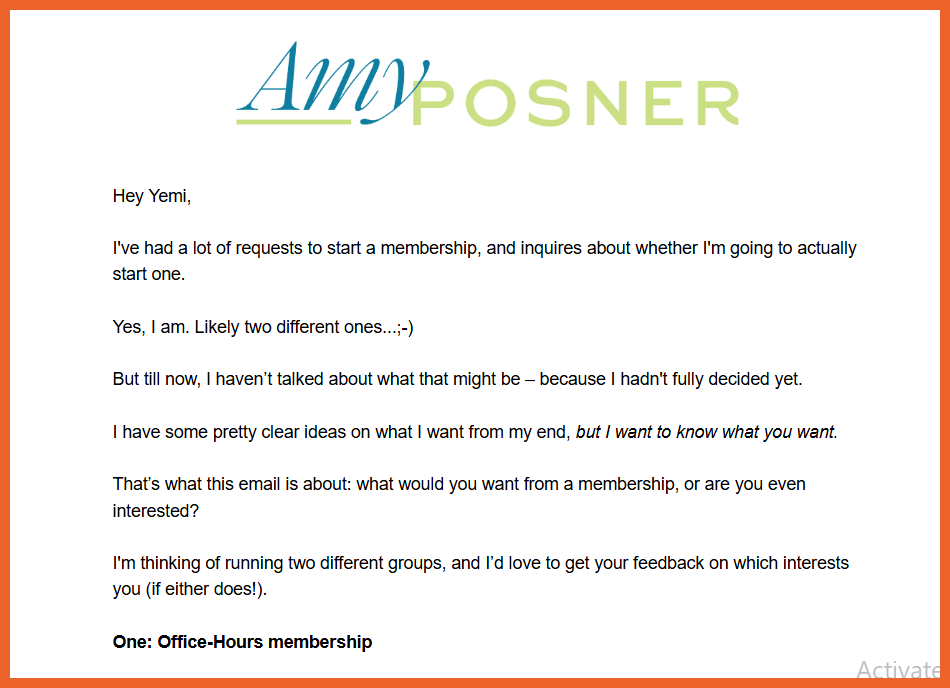
Source: Email from Amy Posner
Build anticipation for the free mini-course
Yes, the goal is to sell your main course (product). But don’t sleep on the free mini-course you promised in phase 1, as it’s your bridge to the sale.
Remind subscribers they’ll be getting a win when it drops. Make it clear when it’s coming, what kind of win they’ll get, and how it ties into the bigger transformation your paid course will deliver.
Besides keeping them engaged with a clear payoff in mind, this makes your emails more value-focused (than just product updates).
For instance, you can have a line like, “The mini-course will help you fix [pain point], so when the [product] drops, you’ll already be ahead.”
An example is this email we sent to our list about conversion strategy, which segued into how our Brevo Mini-Course can help.
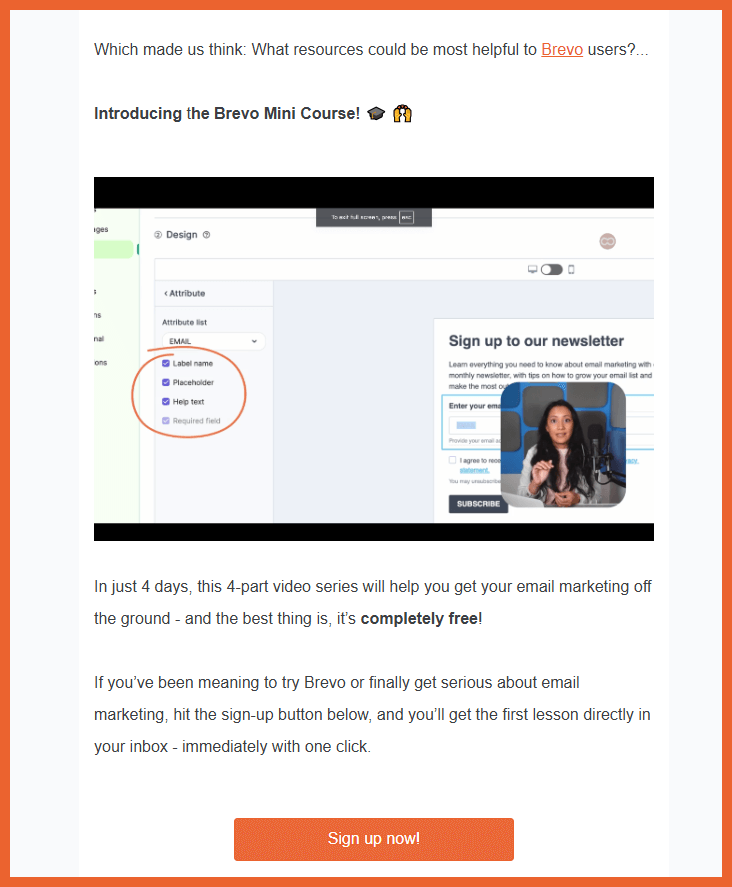
Source: Email from Email Tooltester
Pro Tip: Casually mention what the waitlist has been up to in your regular newsletter or emails to your full list.
For example, “Last week, the waitlist voted on the course name, and they picked a bold one — [XYZ]. (If you’re not on the waitlist yet, this is your sign.)”
Nothing triggers waitlist FOMO like seeing others help shape the product you want.
Phase 3: Build a Bridge
Now, you have an engaged waitlist, it’s time to deliver on your promise of a mini-course.
But the mini-course isn’t “just a freebie.” It’s a test drive that gets them hooked. The proof that your product will work. The bridge between “I’m interested” and “I’m ready to buy.”
And when you help them get a win (before they’ve spent a single dollar), they’ll trust you to help them win again with the paid course.
So, the goal of this phase is to solve a slice of the problem while planting seeds for the bigger solution (your offer) by:
- Making your mini-course specific
- Building in engagement and interactions
- Connecting each lesson to what’s coming next
Here’s how to do it:
Make your mini-course specific
Your mini-course shouldn’t try to solve everything. That’s what the paid offer is for.
Keep it focused on one specific outcome that they can get in 3 to 5 days. And, don’t just dump information, but deliver a breakthrough. Help them make one key mindset shift, solve one pressing pain point, or take one small but meaningful action.
For instance, if your paid offer is to teach them how to sell digital products, you could have a 3-day mini-course on “How to validate a digital product idea that sells.”
An example is our Free Brevo Mini-Course. It’s focused on helping subscribers get started with Brevo, and they learn how to set up opt-in forms, segment their audience, and start sending emails in 4 days.
We also stacked the value by offering an exclusive 50% discount when they sign up for a Brevo paid account.
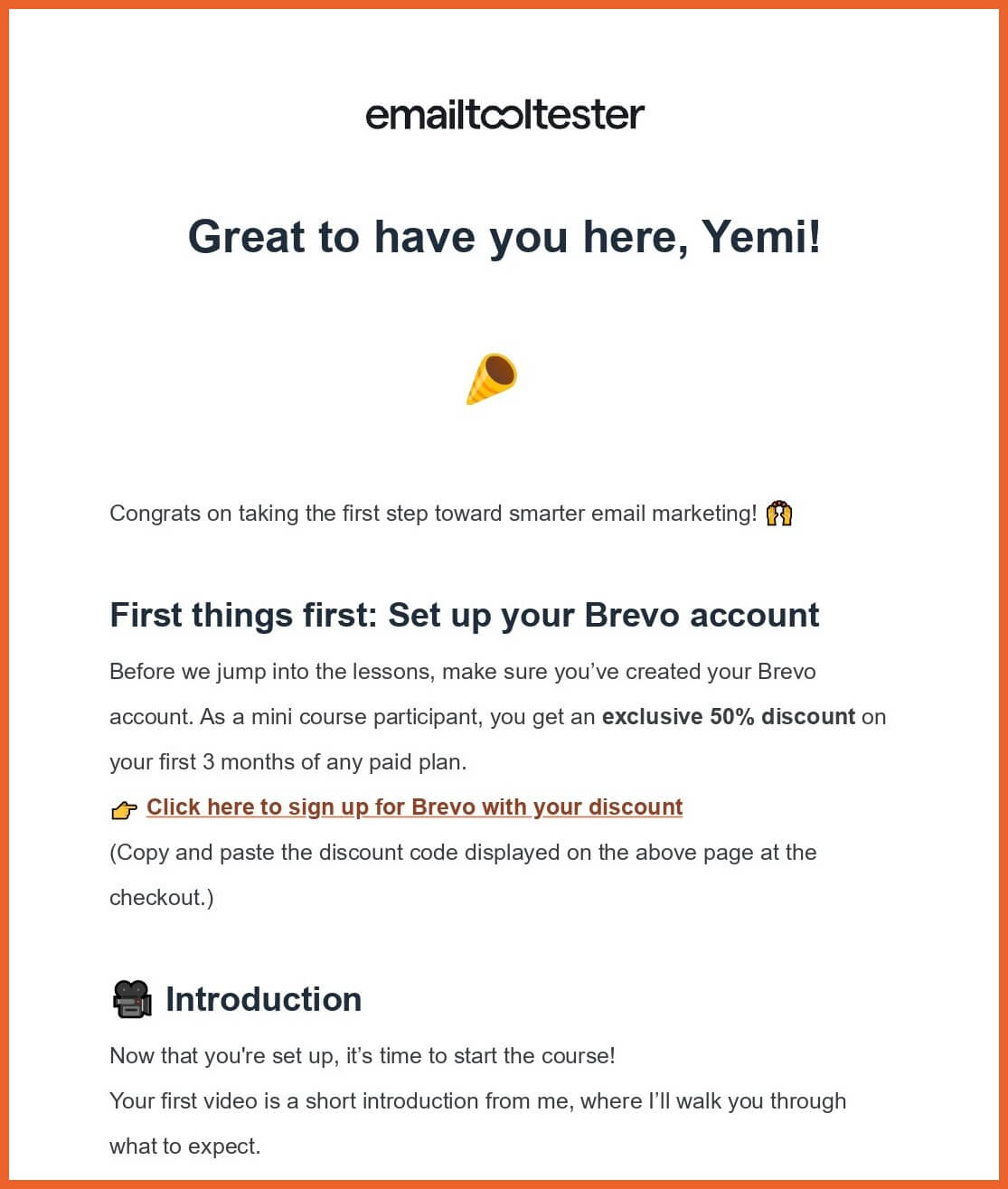
Source: Brevo Mini-Course Email from Email Tooltester
However, the mini-course was just step one. Our paid product, The Mastering Brevo Course, picks up where that leaves off and shows how to set up a full-blown, strategy-backed email marketing campaign.
Build in engagement and interactions
Passive content equals passive subscribers. So, just like you involved your waitlist in the course creation process, you have to interact with them in your email course. Because when you engage with people, they lean in, get invested, and remember you.
You can invite interaction and drive engagement with simple prompts like:
- “Reply and tell me what you uncovered from today’s exercise.”
- “Take a screenshot and tag me if you’re sharing this lesson.”
- “Got it done? Reply with ’Done’ and I’ll cheer you on.”
Doing this builds rapport, creates commitment, and helps you gather social proof that you can use later. (Side note: it also happens to be great for your email deliverability!)
For example, in my mini-course that teaches how to create an email course, I include reply prompts and an easy 3-question quiz to drive engagement (which also improves my CTR).
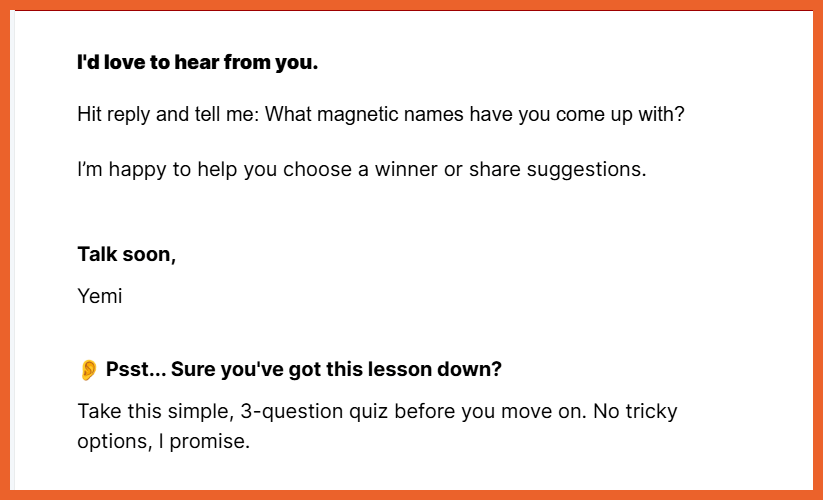
Source: Email course email from Yemi Pelumi
Connect each lesson to what’s coming next
Yes, every email in your free mini-course should deliver a win. But also they should point forward to the bigger transformation they’ll get with your paid offer.
Make sure to foreshadow what’s coming, so when the offer drops, it doesn’t feel like a switch. Because you’ve already planted seeds that position your course (or product) as the obvious next step.
Use simple bridge lines like:
- “In the full program, we build on this to [next-level outcome]…”
- “This is the exact step I cover in more depth inside [course name]”
- “If you like this, wait till you see what Module 2 of [product] helps you do…”
Here’s an example from the free Double Your Freelancing mini-course subtly plugging the paid Double Your Freelancing Rate course.
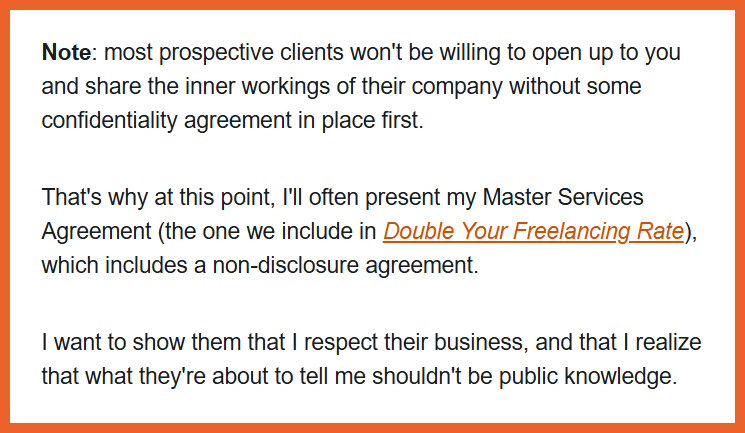
Source: Email from Brennan Dunn (DYF)
Also, don’t forget to remind subscribers taking the mini-course that they’ll get first access to your product + special bonuses for being on your waitlist (and taking the mini-course).
Pro Tip: Once your mini-course is live, send an email to your full list (those not on the waitlist) to let them know and show off some of the wins and feedback you’re getting.
ESP Tip:
- Create an automated email sequence for the mini-course, and trigger it to send only to subscribers tagged “waitlist.”
- Set up the mini-course to trigger immediately and start the sequence for anyone who joins the waitlist late (after the mini-course is ready)
Launch Your Product & Convert Engagement Into Sales
If you’ve done the above three hype phases right, your subscribers are engaged, invested, and ready to buy. Now, it’s time to open the cart.
When you send your launch sequence, it won’t feel like a sales pitch out of nowhere. Because of the work you’ve put in, it’d feel like something your subscribers have been looking forward to.
However, you shouldn’t just announce, “we’re live” and hope they buy (after all you’ve been talking about it for weeks). Instead, be strategic with your launch approach by:
- Launching to your waitlist first
- Crafting a compelling launch sequence
- Offering the option to opt out of the launch
Here’s how to do it:
Launch to your waitlist first
Your waitlist subscribers are your hottest leads. They raised their hand weeks ago. Now’s the time to reward them for it.
Send them early access emails 1–3 days before your public launch and give them something the general list won’t get. Something like a discount offer, an exclusive bonus, or limited 1:1 access.
For example, in addition to the 50% exclusive Brevo discount, we offered subscribers who signed up for the Brevo Mini-Course another 55% discount on our Mastering Brevo Course.
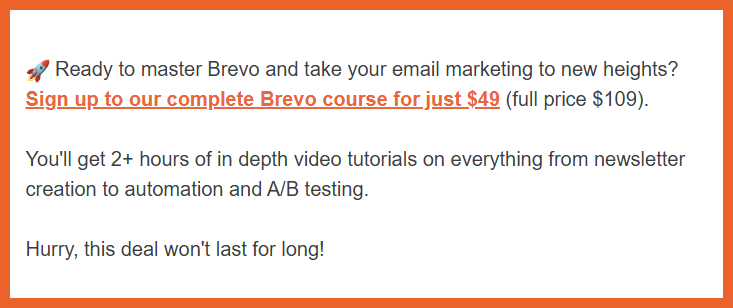
Source: Email from Email Tooltester
Craft a compelling launch sequence
Most creators drop the ball here. They send an “It’s live!” email, a bonus reminder, and one last call, and that’s it. (Or worse, they bombard subscribers with buy now emails).
But your launch sequence won’t convert just by notifying (or harassing) subscribers. When you launch (to your entire list), each email should have a clear purpose and move your subscribers closer to conversion and eventually saying “yes.”
Connect the dots between the pain they felt in phase 1, the progress they made in phase 3, and the transformation your paid offer delivers.
So, it doesn’t feel like you’re just dumping an offer on them. But you’re inviting them to finish the journey they already started.
Here’s a simple 5-email launch flow:
- Email 1: The Reveal
Share what the offer is, who it’s for, and how it builds on the mini-course win.
- Email 2: Objection Crusher
Address the common doubts (e.g., “What if I don’t have time?”). Use testimonials, data, or clear examples
- Email 3: The Case Study or Transformation
Share a beta tester’s result, a client story, or even your own journey. Make it relatable and emotionally resonant
- Email 4: The Bonus Reminder
Remind them what they’ll miss if they delay: limited seats, deadline, or bonus disappearing
- Email 5: The Final Nudge
Reaffirm the transformation. Restate the offer. Close the loop. Remind them why they need to solve the problem.
Offer the option to opt out of launch emails
Not everyone would be interested in your offer, and that’s okay. But if you don’t give them an easy way to say “not right now,” they may click “unsubscribe” instead.
So, when you announce the launch to your full list, include a clear opt-out link or banner. Besides respecting their inbox and reducing unsubscribes and spam complaints, it ensures your launch sequence is focused and targeted at interested subscribers.
Here’s an example from Michal Eisik. In addition to this email, she also added the opt-out option in every email in the launch sequence.
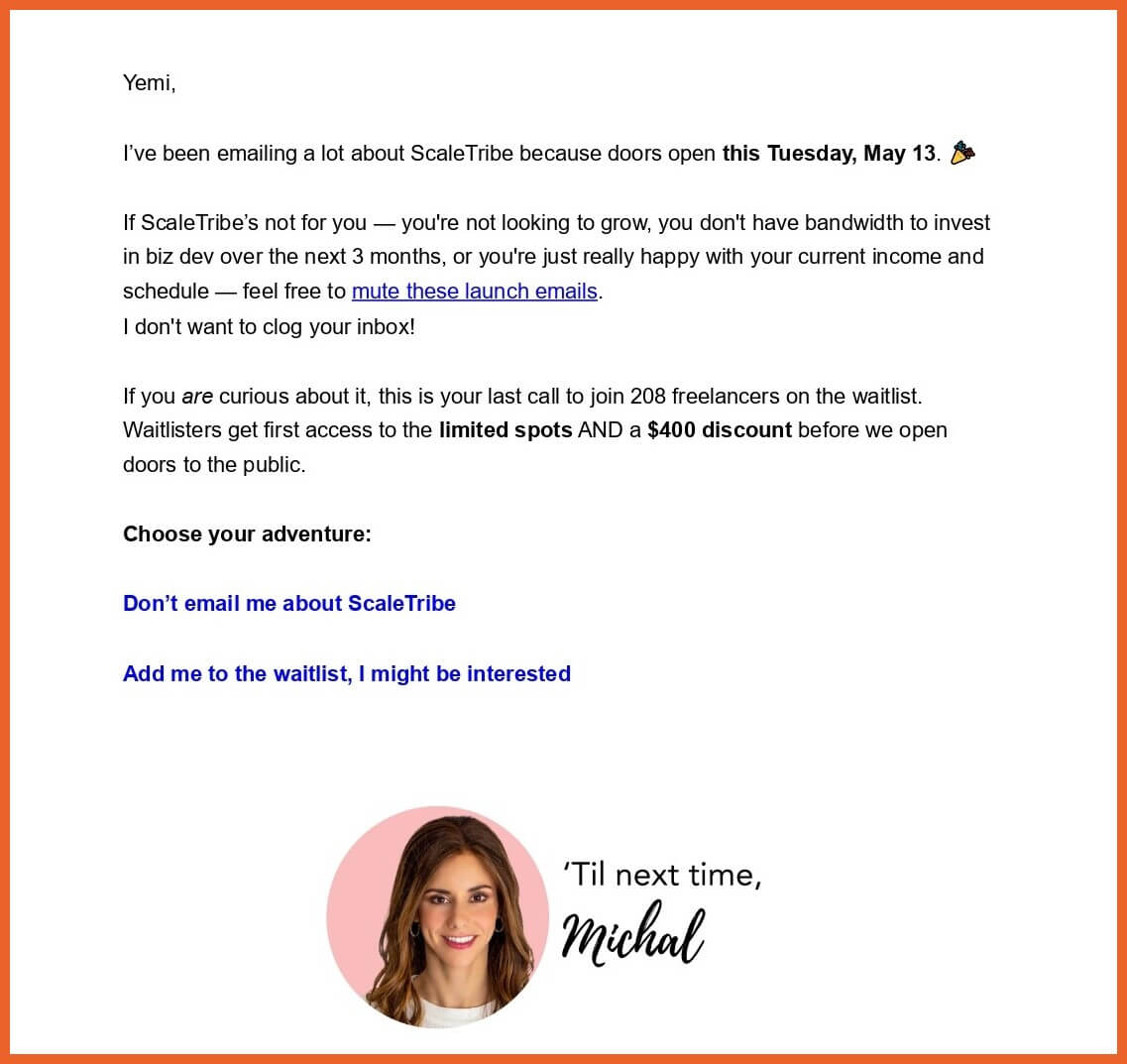
Source: Email from Michal Eisik
ESP Tip:
- Use segmentation or tagging to remove buyers from the launch sequence automatically and move them into the onboarding list
- Use deadline timers or conditional content to show different bonuses or messages based on behavior
Conclusion: A Solid Online Course Launch Strategy is What Drives Conversions – Not Luck
Course launches aren’t successful because of flashy graphics, discount offer announcements, or countdown emails. (Or because your course is so helpful, it’ll be irresistible).
They’re successful because the offer wasn’t just dumped in subscribers’ inboxes a few days before launch day. Rather, the list was engaged, warmed, and primed to say “yes” weeks before the product was ready.
And if you’re thinking, “But isn’t this a lot of emails?” Fair question, because nobody wants to spam their list. But, the answer is, no, it isn’t.
People usually only get tired of random, out-of-the-blue salesy emails that are disconnected from what they need. So as long as your emails remain relevant to your audience, it’s unlikely you’ll have to worry about them tuning you out (or reporting you as spam).
With the 3-phase hype strategy we’ve outlined in this post, your subscribers will welcome your emails. Why? Because it makes them feel seen, delivers value that actually helps, and offers a transformation that they need.
So, if you’re ready to build a course launch that converts, start crafting phase one of the strategy now. Then, set it up on an email service provider (ESP) like Brevo to handle the automation, segmentation, and email delivery.
And if you’re new to ESP setups or considering switching to Brevo, you don’t have to guess your way through it.
Join Our Mastering Brevo Course
In this comprehensive course, you’ll get the full step-by-step walkthrough to warm your list, deliver real value, and launch your course like a pro with Brevo (even if you’re brand new to email marketing).
Join the Mastering Brevo Course
Check out our top picks of email marketing courses
Our Methodology
This article has been written and researched following our EmailTooltester methodology.
Our Methodology